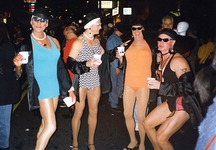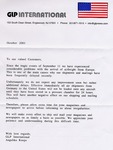 |
| Angelika/Mike Schilli |
|
Angelika We have been following with surprise how American "Halloween" celebrations are enjoying growing popularity in Germany. According to rumors, on October 31st in Germany, there were not only Halloween parties but also children going through neighborhoods trying to collect sweets. Until now, I actually thought that there were enough holidays in Germany. I know that the festival dates back to the Celtic Druids, who celebrated the god of darkness on the night of October 31st to November 1st more than 2000 years ago, and that Christians later transformed the pagan custom into All Saints' Day. The festival eventually came to America with Irish and English immigrants in the mid-19th century.
Germany does not really celebrate Celtic traditions -- the whole thing seems more like "looking towards America" and commerce to me. Halloween costumes and all sorts of spooky masks seem to sell well in Germany too. What scares me the most, however, is the thought that we might one day live in Germany again and won't have to adjust much. How boring life is when you encounter the same thing everywhere! The big cities of this world already give a taste of that. Travelers encounter McDonald's and Kentucky Fried Chicken everywhere. Department stores in London, Paris, Berlin, Sydney, New York, and Hong Kong offer Levis, Calvin Klein, Esprit, Benetton, and the like. I don't even want there to be a GAP (an American clothing chain based in San Francisco) in Munich, or for the American coffeehouse chain "Starbucks" to make its way into Germany. Admittedly, I often miss various things here, like Bahlsen's peanut flips, but there's nothing more delightful for me than indulging in a bag during a visit to Germany or joyfully receiving a "care package" from Germany containing treats we can't get here. Feel free to think I'm a bit crazy. To anyone who doesn't believe this horror of uniformity actually exists, I recommend a tour through American suburbs. There, you mostly find shopping centers with the same stores. Everything is completely interchangeable, whether you're in California, Idaho, or anywhere else in the USA.
Once again back to "Halloween": The term is composed of the three words "All Hallows Eve," which means "the night before All Saints' Day." Here in the USA, children dress up in costumes and roam the streets, going from door to door or even from store to store, and threaten to "trick or treat" -- loosely translated: Either you hand over the candy, or we'll play a trick on you. A popular activity around Halloween is for American families to go to so-called "Pumpkin Patches" (pumpkin farms) and pick out pumpkins, which are then hollowed out and carved with funny or spooky faces. On Halloween, a candle is placed inside the hollowed-out pumpkin, making the face glow.
This year, even "Halloween" was overshadowed by the terrorist attacks in September. Many security experts expressed concerns about the crowds at various Halloween parties that took place on the streets of several cities on October 31st. As a result, many cities canceled their events. However, San Francisco was not deterred. For years, there had been a street party in the Castro, San Francisco's gay district, during Halloween. There, you can see not only the most amazing costumes, but the atmosphere is also truly lively. No one wanted to miss out on the fun. By the way, the party in the Castro district is unofficial. The city of San Francisco has been trying for some time to move the party entirely to Civic Center (where San Francisco's City Hall is located) because Castro Street is relatively narrow and can hardly accommodate the large crowds--there simply isn't enough space. So now the official party always takes place at the Civic Center, which no one seems to care about, and everyone goes to celebrate in the Castro.
The safety of Halloween is generally a constant topic in America, especially concerning children who go from door to door. Several years ago, a few completely deranged individuals hid razor blades in oranges that they gave to children at the door, so now only pre-packaged candies are being distributed. Stores sell candy in bulk before Halloween, and all the candies are individually wrapped. Many families who live in less safe neighborhoods (meaning: rough areas with burning trash cans -- Michael) drive with their children to safer areas and let them go door to door there. With the children in the Tenderloin (where I still volunteer twice a week), we always take the same route, as the Tenderloin is known to be one of the somewhat less safe areas in San Francisco. But even the candies that the business owners we know give to the children cannot be eaten immediately, as there is a rule that parents must first inspect the candies for safety reasons when they pick up their children. And it's not just about potential allergies. It's all very sad.














